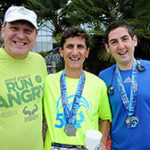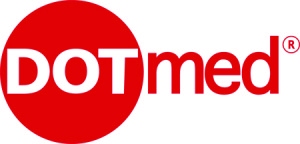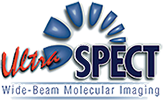Congratulations to Lucky Winners of 10th Anniversary Sweepstakes!
 Thank you to everyone who entered the sweepstakes dedicated to celebrating UltraSPECT’s 10th anniversary of the FDA approval of the WBR technology! The lucky winners of $50-gift card from either Amazon, iTunes, Starbucks, Dunkin' Donuts or Barnes & Noble are included below:
Thank you to everyone who entered the sweepstakes dedicated to celebrating UltraSPECT’s 10th anniversary of the FDA approval of the WBR technology! The lucky winners of $50-gift card from either Amazon, iTunes, Starbucks, Dunkin' Donuts or Barnes & Noble are included below:
Becky McGoum, OH; Kimberly Holmes, IN; Clarito Dimayuga, CA; Robert Pagnanelli, NC; Chris Tollefson, AZ; Steve Bartosik, OH; Mark Cummins, OH; and Marcela Martinez, FL.
SNMMI "Hot Trot 5K" Run/Walk a Success

Dan Basso, University Health Care System, Augusta, Ga., Yossi Srour, UltraSPECT, and Aviv Srour at the “Hot Trot 5K”.
More than 400 nuclear medicine professionals took part in this year’s "Hot Trot 5K" run/walk held during the 2016 Society of Nuclear Medicine & Molecular Imaging (SNMMI) meeting. Embarcadero Marina Park in San Diego provided a beautiful setting for the fun fitness event, and the winner time was about 17 minutes – we have some really good runners in our midst! The run/walk was followed by a breakfast and raffles – what a great way to start the day and support the SNMMI Technologist Quality Initiative!
Voices from SNMMI: Impressions & Trends
 Have you made it to the SNMMI meeting this year, or are you getting your insights from news and colleagues? We spoke to Ryan Paul, Imaging Supervisor at Atlanta Heart Specialists in Tucker, Ga., who attended the event for the first time on behalf of UltraSPECT.
Have you made it to the SNMMI meeting this year, or are you getting your insights from news and colleagues? We spoke to Ryan Paul, Imaging Supervisor at Atlanta Heart Specialists in Tucker, Ga., who attended the event for the first time on behalf of UltraSPECT.
Q: How was the SNMMI meeting this year?
RP: SNMMI couldn't have done a better job with the location: plenty of site seeing, great food, fantastic weather, hospitable locals, catchy tunes from The Thallium Stallions - what more could we ask for?
Q: What stood out for you at the show?
RP: During my time at the UltraSPECT booth, the real eye-opener was how many of the non-US based attendees were genuinely interested in the WBR's line of products. It's great to see other countries share a common goal in reducing patient ionizing exposure, as well as raising the bar for patient comfort and diagnostic image quality.
Q: Did you notice any trends shaping up as you toured the floor?
RP: It was refreshing to see a few companies, for e.g., Northstar and Perma-Fix, in the forefront of bringing non-HEU based Moly-99 to the US. Being able to provide the nation with a stable supply of Technetium has been a huge endeavor in itself, let alone when it has to be derived from non-HEU sources. It became very apparent after speaking to the representatives at each of their respective booths that the days of your radiopharmacy calling in to say they are out of “Tech” are numbered.
While a few of the major OEMs unveiled their latest gamma cameras, as someone who spends some time digging through patents, I was somewhat underwhelmed. What attendees didn't see was that a number of OEMs are working on novel solid-state, modular designs that, in my opinion, will lead to a huge paradigm shift within the field. Perhaps during this year’s ASNC, one of them can give us a sneak-peak?
The pulse at AIS and BC Technical was very strong. Both companies have a dominant presence in the refurbished market, with AIS rapidly expanding its Mediso install base, and BC Technical formidably acquiring a slew of companies, which will grant them quite the geographic footprint as the de facto OEM-alternative.
Are You Up-to-Date on Nuclear Market Trends?
 Read all about nuclear medicine market trends in the June issue of DotMed’s Healthcare Business News, featuring insights from Yossi Srour, President of UltraSPECT, “Molecular imaging market expands amid challenges.”
Read all about nuclear medicine market trends in the June issue of DotMed’s Healthcare Business News, featuring insights from Yossi Srour, President of UltraSPECT, “Molecular imaging market expands amid challenges.”
Q&A With Yossi Srour: a Close-Up on Market Trends
 Q: What are some changes you’ve seen in the molecular imaging market?
Q: What are some changes you’ve seen in the molecular imaging market?
Y.S.: Although the cost associated with PET-CT service is still high, PET market is expected to witness more growth compared to SPECT imaging as it provides higher resolution images. Additionally, shortage of technetium-99m is propelling the industry to look for alternative diagnostic procedures. There is also an increased awareness of the diagnostic benefits of radiopharmaceuticals and a few novel clinical applications, such as for the Alzheimer’s disease and oncology applications, all of which is also driving the market.
Q: Are there any major trends that you’ve noticed?
Y.S.: The trends are determined by the rise in cardiac disease incidence, the need to cope with the market constraints such as shortages in the radioisotopes supply chain, regulatory guidelines, reimbursement issues and high capital investment.
The scientific discussions and literature have been focusing on new tracers, hybrid systems such as SPECT/CT, PET/CT, PET/MR and, lately SPECT/MR emerging technologies, both software and hardware for new and old equipment; molecular breast imaging, and other techniques for enhancing the diagnostic capabilities.
However, the majority of nuclear laboratories still use legacy imaging systems and have limited resources to buy new equipment. They will continue focusing on such actions as replace and/or retrofitting the old equipment; complying with the ASNC guidelines for low-dose imaging; complying with the PQRS requirement to obtain additional 2% in CMS reimbursement, with Image Wisely and Image Gently, and the ALARA radiation safety principle; as well as addressing the patients’ growing awareness of the need for low-dose imaging. Securing the supply chain due to the growing shortages of Tc-99m isotope by using low-dose imaging remains important.
Q: What are some changes you’ve noticed in the way PET/CT are being utilized?
Y.S.: Analyzing the applications segment of SPECT vs. PET, PET is being used primarily in oncology because of good quality imaging while SPECT is used primarily in cardiology segment accounting for almost 90% of the cardiology market share. The rapid growth in the use of cardiac PET has slowed down since the recall of rubidium-82 by FDA due to quality control issues due to potential for increased radiation exposure in patients (July 2011). However, in the last two years, the PET market has again been growing due to an increasing number of peer-reviewed papers discussing the superior accuracy of Rb-82 PET in detection of obstructive CAD. Moreover, despite advances in SPECT technology, PET remains superior with regard to image quality.
Q: Are there any new technologies in the market that you’re excited about?
Y.S.: My personal interest is the enhancement of the legacy systems, so any technology to improve the image quality, reduce the exposure to radiation and shorten the scan time is of interest to me. These include hardware and software solutions retrofitting and/or replacing the excising nuclear equipment.
Given the tremendous opportunities presented by integrating imaging modalities with different strengths, it is not surprising that several other hybrid combinations are being explored. Some of these are primarily presented at scientific talks such as nuclear medicine and optical imaging systems (optical/PET and optical/SPECT), X-Ray/MR and optical/MR. Additionally, I must mention that multimodality imaging agents may offer a powerful way to interrogate biological targets and that they are highly complementary to the hybrid imaging systems that are being developed.
Q: How will molecular imaging application look five or ten years down the road?
Y.S.: In the last few years, many nuclear outpatient laboratories have been merged into hospitals, which in most cases put nuclear medicine under radiology. With the hybrid technologies discussed above and the merger trend, ten years down the road, we will find molecular imaging as part of diagnostic imaging. Most of the nuclear modalities will be part of hybrid systems, the reading will be done jointly on the same reading system connected to PACS system and hospital HIS/RIS systems. All add-on software, workstations, visualization systems, CAD systems will be integrated into one huge server/cloud.

